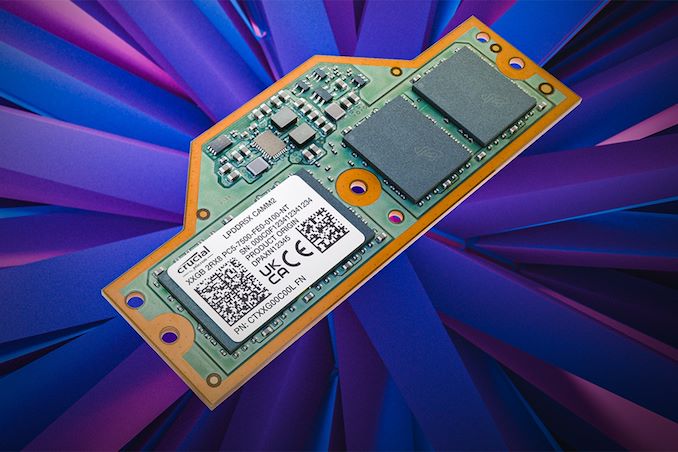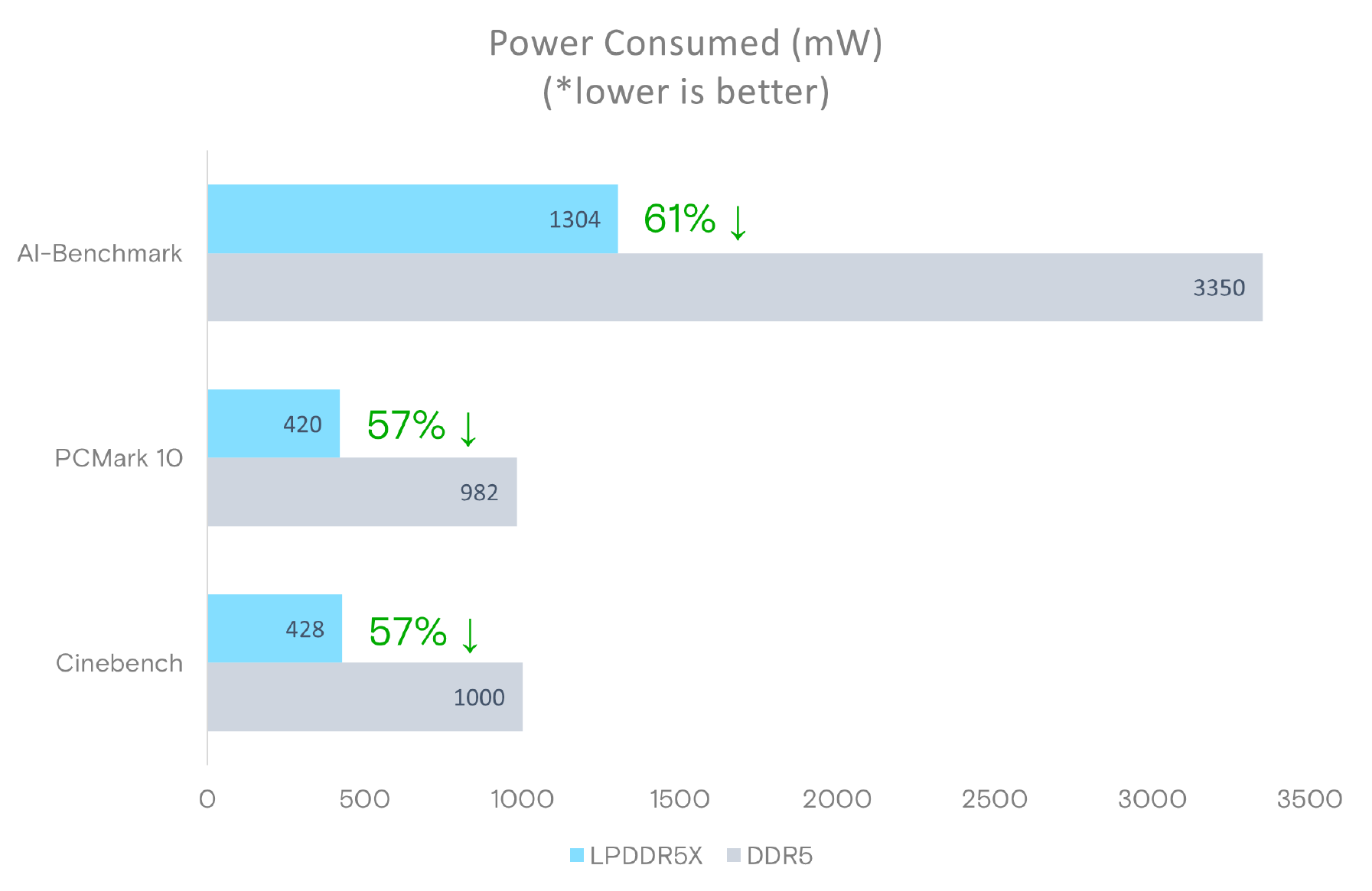Micron Ships Crucial-Branded LPCAMM2 Memory Modules: 64GB of LPDDR5X For $330
by Anton Shilov on May 8, 2024 6:30 PM EST
As LPCAMM2 adoption begins, the first retail memory modules are finally starting to hit the retail market, courtesy of Micron. The memory manufacturer has begun selling their LPDDR5X-based LPCAMM2 memory modules under their in-house Crucial brand, making them available on the latter's storefront. Timed to coincide with the release of Lenovo's ThinkPad P1 Gen 7 laptop – the first retail laptop designed to use the memory modules – this marks the de facto start of the eagerly-awaited modular LPDDR5X memory era.
Micron's Low Power Compression Attached Memory Module 2 (LPCAMM2) modules are available in capacities of 32 GB and 64 GB. These are dual-channel modules that feature a 128-bit wide interface, and are based around LPDDR5X memory running at data rates up to 7500 MT/s. This gives a single LPCAMM2 a peak bandwidth of 120 GB/s. Micron is not disclosing the latencies of its LPCAMM2 memory modules, but it says that high data transfer rates of LPDDR5X compensate for the extended timings.
Micron says that LPDDR5X memory offers significantly lower power consumption, with active power per 64-bit bus being 43-58% lower than DDR5 at the same speed, and standby power up to 80% lower. Meanwhile, similar to DDR5 modules, LPCAMM2 modules include a power management IC and voltage regulating circuitry, which provides module manufacturers additional opportunities to reduce power consumption of their products.

Source: Micron LPDDR5X LPCAMM2 Technical Brief
It's worth noting, however, that at least for the first generation of LPCAMM2 modules, system vendors will need to pick between modularity and performance. While soldered-down LPDDR5X memory is available at speeds up to 8533 MT/sec – and with 9600 MT/sec on the horizon – the fastest LPCAMM2 modules planned for this year by both Micron and rival Samsung will be running at 7500 MT/sec. So vendors will have to choose between the flexibility of offering modular LPDDR5X, or the higher bandwidth (and space savings) offered by soldering down their memory.
Micron, for its part, is projecting that 9600 MT/sec LPCAMM2 modules will be available by 2026. Though it's all but certain that faster memory will also be avaialble in the same timeframe.
Micron's Crucial LPDDR5X 32 GB module costs $174.99, whereas a 64 GB module costs $329.99.
Source: Micron










13 Comments
View All Comments
nandnandnand - Wednesday, May 8, 2024 - link
I paid about $90 for 64 GB DDR4-3600 a couple months ago, probably the lowest it's going to be now that DRAM prices are rising. These prices are high but they not nearly as bad as they could be for getting it out of the gate. I hope we see some real adoption in laptops, mini PCs, and maybe even Mini-ITX boards.Nice that you can get dual-channel in one module, although that is optional, and I recall JEDEC plans to allow stacking of two modules.
About the capacity, what are the largest chips that could fit on a CAMM? SK Hynix is making 24 GB LPDDR5X packages, so with four of those we could seemingly see a 96 GB module today. Back before the form factor was standardized, we saw different module sizes that could hold more RAM, so how about 192 GB on a single module with double the length?
Dolda2000 - Wednesday, May 8, 2024 - link
While I'm not a huge fan of the fact that each channel doesn't go to an independent module, this is certainly a big step up from soldered RAM, and downgrading from 8533 MHz to 7500 MHz seems like a virtually obvious tradeoff to make to have modular RAM!I will say, though, that just because LPDDR had to be soldered prior to compression-attached modules, I don't see how that was ever an excuse for device vendors to not publish service manuals with memory jumper settings so that those of us who can solder (or are capable of going to third-party service shops) could have upgradable LPDDR since forever.
nandnandnand - Wednesday, May 8, 2024 - link
"While I'm not a huge fan of the fact that each channel doesn't go to an independent module"Does that matter? It's going to result in more devices having dual-channel.
However there will also be single-channel modules, possibly even with high capacity:
https://forums.anandtech.com/threads/camm2-memory-...
"1-channel CAMMs expected to be used where high memory capacity per channel is required."
Micron has talked about LPDDR5X-9600 for CAMM as the article notes, so I'm not sure there is a tradeoff yet. They are just starting out with modest speeds. Might be what the customers want, 8533 MT/s is not so common yet.
Dolda2000 - Thursday, May 9, 2024 - link
>Does that matter? It's going to result in more devices having dual-channel.Fair enough, I guess. I've been appreciating being able to upgrade those originally single-channel configurations without having to replace and waste the original DIMM, but yeah, I see where you're coming from for sure.
meacupla - Thursday, May 9, 2024 - link
Doesn't Samsung have LPDDR5X 10700?nandnandnand - Thursday, May 9, 2024 - link
What product is using LPDDR5X-10700? Meteor Lake and Hawk Point memory controllers max out at 7467/7500.meacupla - Thursday, May 9, 2024 - link
It's announced, so it's probably in validation stage with various SoC and CPUs.Dante Verizon - Thursday, May 9, 2024 - link
The fastest available operates at 8533MhzSamus - Thursday, May 9, 2024 - link
Unfortunately with the higher cost of the modules, integration into motherboards, and lower performance, I don't see these being adopted as widely as I hoped.meacupla - Thursday, May 9, 2024 - link
for comparison, crucial ddr5 5600 sodimm is $110 for 2x16gb, and $230 for 2x 32gb.